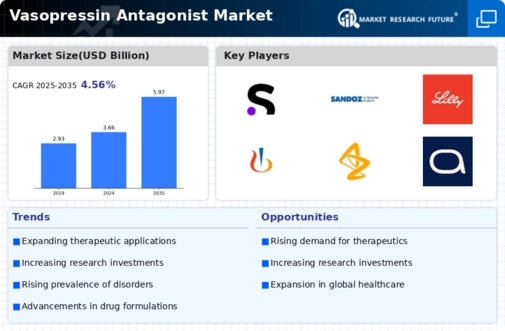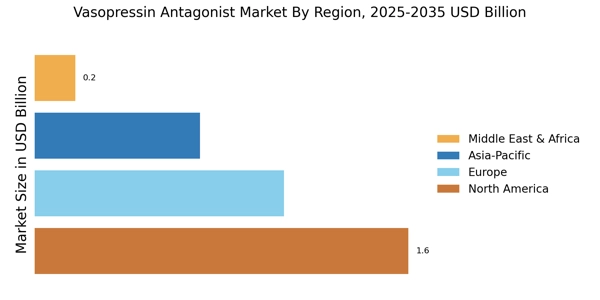Rising Geriatric Population
The growing geriatric population is a significant driver for the Vasopressin Antagonist Market. Older adults are more susceptible to conditions that require vasopressin antagonists, such as heart failure and hyponatremia. As the global population ages, the demand for effective treatments for these conditions is likely to escalate. It is estimated that by 2030, the number of individuals aged 65 and older will surpass 1 billion, creating a substantial market for vasopressin antagonists. This demographic shift underscores the importance of addressing the healthcare needs of older adults, thereby propelling the Vasopressin Antagonist Market.
Advancements in Drug Formulations
Innovations in drug formulations are significantly influencing the Vasopressin Antagonist Market. The development of more effective and targeted vasopressin antagonists, such as tolvaptan, has shown promise in treating conditions like heart failure and hyponatremia. These advancements not only enhance therapeutic efficacy but also improve patient compliance due to better dosing regimens and reduced side effects. The market for vasopressin antagonists is projected to grow at a compound annual growth rate of approximately 8% over the next few years, driven by these advancements in drug formulations. As pharmaceutical companies continue to invest in research and development, the Vasopressin Antagonist Market is expected to expand further.
Growing Awareness of Rare Diseases
The increasing awareness and diagnosis of rare diseases, particularly those related to water retention disorders, are propelling the Vasopressin Antagonist Market. Conditions such as nephrogenic diabetes insipidus and syndrome of inappropriate antidiuretic hormone secretion (SIADH) are gaining recognition, leading to a higher demand for effective treatment options. As healthcare providers become more informed about these conditions, the utilization of vasopressin antagonists is likely to rise. This trend is supported by the fact that the market for rare disease treatments is expected to reach over 200 billion USD by 2025, indicating a substantial opportunity for the Vasopressin Antagonist Market.
Regulatory Support for New Therapies
Regulatory bodies are increasingly supportive of new therapies, which is beneficial for the Vasopressin Antagonist Market. The expedited approval processes for innovative drugs, particularly those addressing unmet medical needs, encourage pharmaceutical companies to invest in the development of vasopressin antagonists. This regulatory environment not only facilitates quicker market entry for new products but also enhances competition among manufacturers. As a result, the availability of diverse treatment options is likely to increase, thereby expanding the Vasopressin Antagonist Market. The favorable regulatory landscape is expected to contribute to a robust growth trajectory for this market segment.
Increasing Prevalence of Hyponatremia
The rising incidence of hyponatremia, a condition characterized by low sodium levels in the blood, is a primary driver for the Vasopressin Antagonist Market. This condition is often associated with various medical conditions, including heart failure and liver cirrhosis. As the population ages, the prevalence of these underlying conditions is likely to increase, thereby boosting the demand for vasopressin antagonists. According to recent estimates, the prevalence of hyponatremia in hospitalized patients can reach up to 30%. This growing patient population necessitates effective treatment options, which in turn propels the Vasopressin Antagonist Market forward.


















Leave a Comment